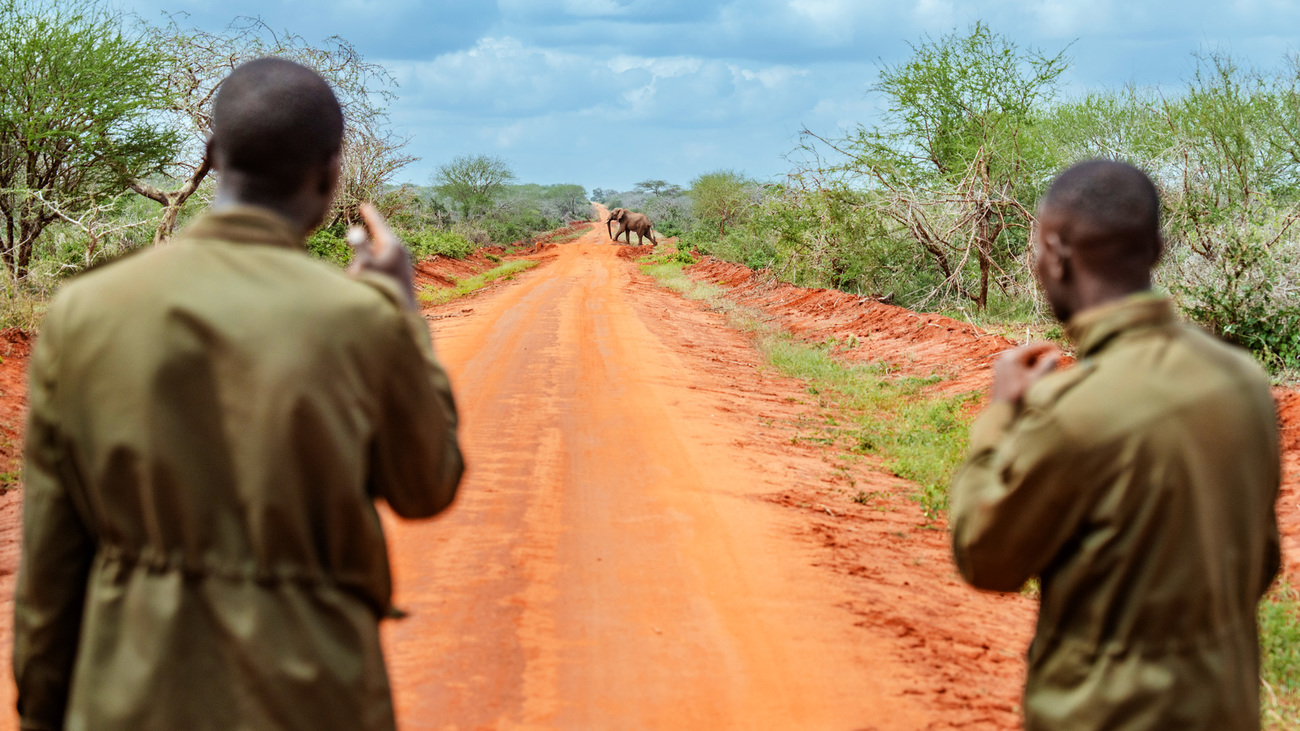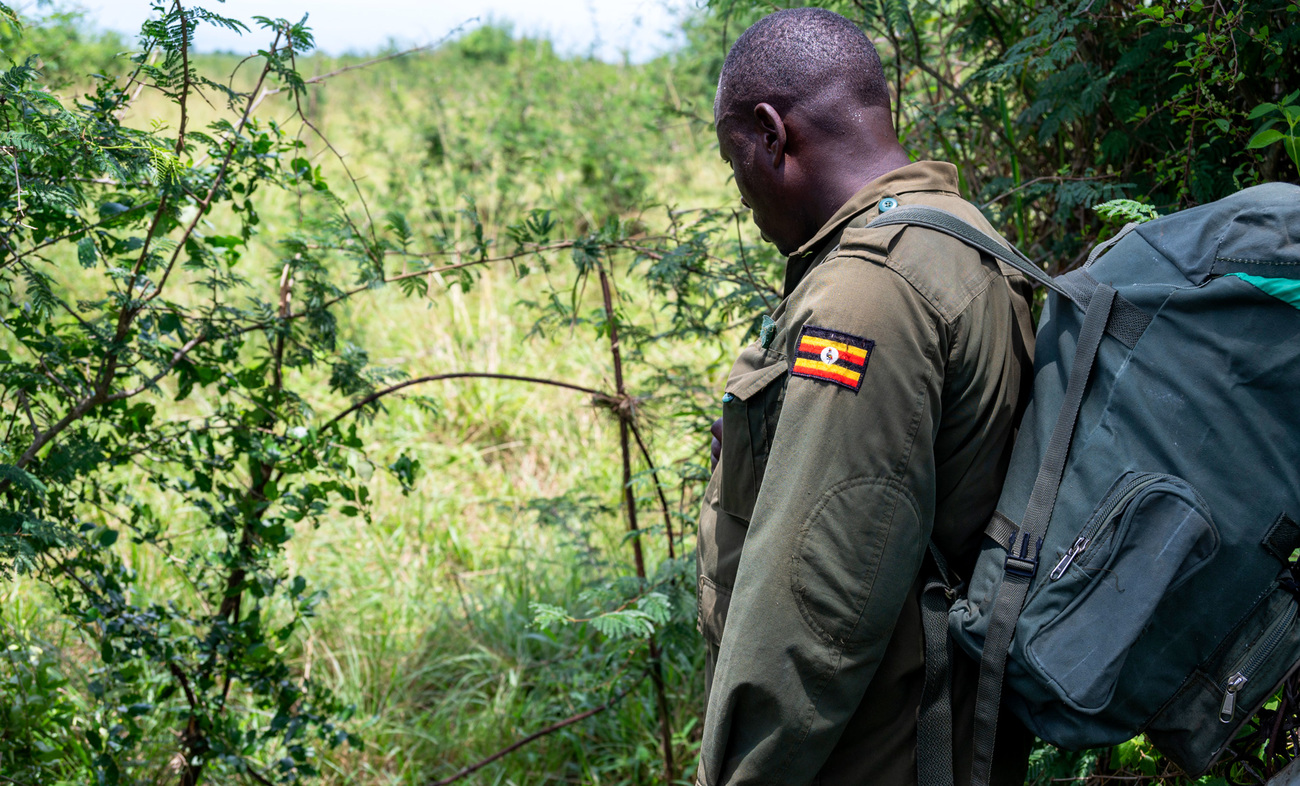Moses Olinga
How improving ranger welfare can help us fight the climate crisis
How improving ranger welfare can help us fight the climate crisis
I’ve spent more than two decades working on species conservation and wildlife law enforcement in Africa. From the mountain forests of my home country of Uganda to the highlands of Ethiopia to the savannahs of Queen Elizabeth and Virunga National Parks, I’ve met thousands of park rangers tasked with patrolling, managing, and safeguarding protected areas, some of which are the last hope for the survival of threatened species including gorillas, rhinos, and elephants. After years of witnessing all that rangers sacrifice in the line of duty, two things are clear: they are conservation heroes, and we are letting them down.

Improving the welfare of rangers worldwide isn’t just the right thing to do. It’s also critical to curb the twin crises threatening life on Earth: climate change and biodiversity loss.
Huge responsibilities—and too little support
Across the globe, rangers are on the front lines of protecting the planet’s last remaining ecosystems and the wildlife they sustain. Rangers patrol protected areas looking for poachers and loggers. They collect data on threatened wildlife populations. They remove inhumane snare traps, reducing the chance of animals being maimed or killed. And they act as a bridge to local communities, doing everything from managing human-wildlife conflict to teaching children about the unique species found in their backyards.
But these daily tasks ignore the difficult conditions under which many rangers operate. Because most parks are in remote areas and many cannot accommodate families, many rangers must live apart from their loved ones, sometimes only seeing them a few times a year. Housing is very basic, often cinderblock bunkrooms with tin roofs and minimal temperature control. Due to limited resources, they may not have access to good uniforms or sturdy boots, or even lack transport to adequately patrol the park. In countries with unstable governments, rangers may go without salary payments for months. Living far from hospitals is another challenge—if someone falls sick or is injured on the job, it can be a nightmare to evacuate them.
And sometimes the consequences are worse: More than 100 rangers around the world die on the job every year. While the majority succumb to illness or accidents, between 2006 and 2021, more than 42% of ranger deaths were the result of human violence. Some of those deaths occur during conflicts with communities; for example, since 2002, 15 rangers have lost their lives and 35 others have been maimed for life in Uganda’s Mount Elgon National Park in clashes related to villagers encroaching on the park’s fertile mountain slopes for agriculture. An increasingly common situation across the globe as human populations grow and available land becomes scarcer, this underlines the need to help communities near protected areas improve crop yields and realize more benefits from conserving ecosystems than from destroying them.
However, the majority of rangers who are murdered in the line of duty are killed by poachers or others connected to organized crime. These groups go for lucrative products such as ivory, and the poachers are armed and not easily deterred due to the large potential payout coupled with the low risk of getting caught.
Tragically, ranger casualties appear to be increasing worldwide. The death of every ranger leaves behind a family that not only must cope with the painful loss of a relative, but also the disappearance of a source of income that may have paid for essentials like school fees, medical care, and other support.

The consequences of under-investing in rangers
When they are well-staffed and well-resourced, rangers play a vital role in preserving the integrity of protected areas. Their presence can help determine whether a rare wildlife species boosts its numbers or plummets to extinction, whether an ecosystem thrives or unravels, if a region’s natural legacy will be left for the next generation.
This is a heavy responsibility, and one that is impossible to meet if rangers don’t receive the support they need. With insufficient resources, rangers will not be able to patrol. If they don’t have enough food, adequate shelter, or uniforms, all that affects their performance — and makes it easier for poachers and loggers to illegally breach the park boundaries.
Rangers are integral to the world’s chances of preventing the most dangerous climate impacts. Two destructive activities that rangers work to prevent can reinforce each other: Killing keystone species such as elephants and gorillas degrades their habitats by removing essential seed dispersers and disrupting the balance of the food web. Meanwhile, cutting timber (particularly large old-growth trees) releases carbon dioxide into the atmosphere, contributing to climate change and making it even harder for already-rare species to survive. Protecting tropical forests, peatlands and other carbon-rich habitats is essential for many low-income countries to achieve their national climate goals under the Paris Agreement.
In addition, if a protected area doesn’t have enough rangers to manage it, there is a greater chance of incidents of human-wildlife conflict. For example, savannah elephants have been known to raid corn fields, matoke gardens, and other cash crops, which not only hurts the income of local farmers, but can be dangerous for both elephants (who may be shot or speared in retaliation) and people (who run the risk of being trampled if they try to intervene).
With the climate and extinction crises well underway, ranger welfare could make or break whether a particular park becomes a model for conservation and climate action—or buckles under the pressure from so many outside threats.
The solution: More rangers and better support
How can we make sure that rangers have the support they need to do their jobs?
First, conservation success depends on encouraging buy-in from local communities by ensuring that they benefit from the parks we are trying to protect. In Kenya, IFAW supports teams of community rangers—residents from local communities trained in activities such as wildlife monitoring and patrolling whose work can complement the work of government rangers. For example, in 2023 IFAW provided community rangers in Mgeno Wildlife Conservancy with motorcycles, allowing them to more quickly respond to threats and better serve their communities.

Community rangers play a crucial role in conservation, as animal populations do not adhere to human-drawn boundaries; in Kenya, for example, a 2021 wildlife census indicated that more than 50% of wildlife can be found on community lands, not official protected areas. At the same time, being trained as a community ranger can provide rare job opportunities to people with few options, such as the Maasai women who make up Team Lioness, one of Kenya’s first all-women ranger units. By providing fair salaries, training, transport, medical support and more for these community rangers, we are incentivising local protection while reducing the workload of government rangers.
Second, we must provide enough rangers to adequately patrol protected areas and assist when conflicts with wildlife arise in nearby communities. For example, IFAW’s Room to Roam initiative is working to establish open corridors that will allow African elephants to once again travel large distances across country borders and between fragmented habitats, interacting and breeding with other elephant groups and minimising human-wildlife conflict. This will only be possible with a large ranger force that is able to monitor species movement and respond quickly when elephants are coming into conflict with people to prevent anyone from getting hurt.
Third, we must improve welfare for rangers. At the peak of the COVID-19 pandemic, IFAW provided essential resources including food, fuel, veterinary medicine, and training on species identification and poaching detection to rangers in Uganda’s Queen Elizabeth National Park. This alongside other interventions helped mitigate poaching during that period.

To see what success looks like, we should consider what’s happening in parts of East Africa, specifically Kenya, Tanzania, and Uganda. Between 2010 and 2016, these countries experienced an uptick in elephant poaching that took a dramatic toll on overall numbers. But since 2017, there has been a remarkable turnaround; poaching for the illegal wildlife trade has decreased (although hunting for bushmeat is still increasing), and populations of elephants and other large mammals are beginning to stabilize. We attribute this to a variety of factors, including that in general these countries have well-managed, well-trained ranger forces with the resources they need to do their work and to respond to threats. In comparison, protected areas in countries such as South Sudan, whose rangers are chronically under-funded and resourced, continue to be pummeled by poaching to fuel the ivory trade; in the last 15 years, South Sudan’s elephant population has been cut in half with fewer than 2,500 animals remaining.
Because most rangers are government employees, the stability of national governments is a key factor in ranger welfare. National, regional, and local governments must be at the forefront of ensuring that ranger welfare is taken care of, but when governments are failing to do so, we can’t sit by and let our countries’ natural heritage disappear. As we’ve seen in places like Kenya, conservancies managed by communities and other private actors have a critical role to play in conservation of lands outside protected area boundaries. In Queen Elizabeth National Park in Uganda, IFAW supports community monitors who act as informants and provide timely information to rangers on poaching incidents; their tips have resulted both in preventing poaching and the arrests of poachers after the crime occurs.
The sooner we give the world’s rangers the support they deserve, the better chance we have at fighting the biodiversity loss and climate crises. In the 1980s, Uganda lost the northern white rhino due to civil war and poaching; the species is now functionally extinct, with only two (female) individuals remaining on Earth at Olpejata Conservancy in Kenya. We must ensure that we will never again just sit back and watch such a devastating occurrence. We need a future where our natural legacy can continue to provide for and inspire future generations.
Related content
Our work can’t get done without you. Please give what you can to help animals thrive.